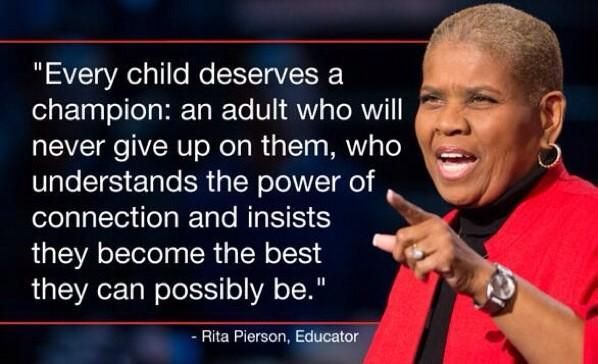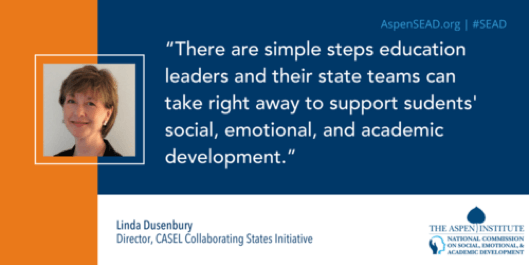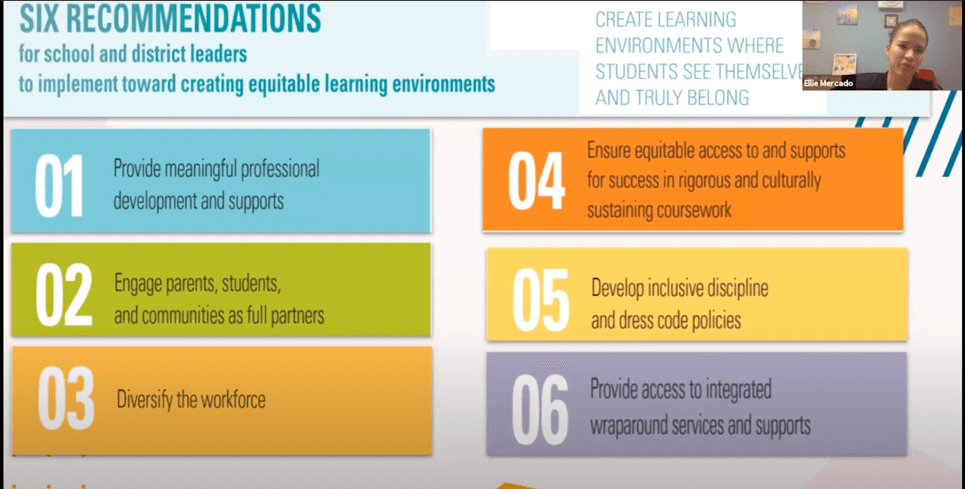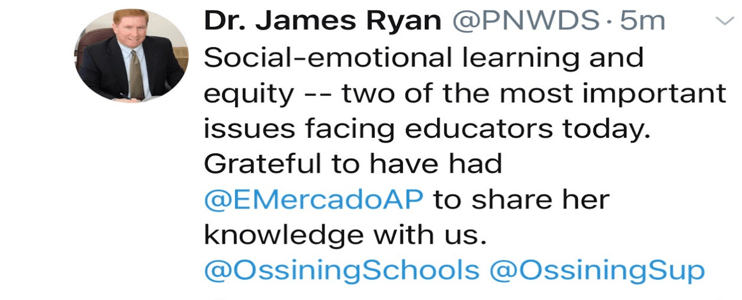"Every child deserves a champion: an adult who will never give up on them, who understands the power of connection and insists they become the best they can possibly be." Rita Pierson, Educator.

Watch this interview on YouTube here https://youtu.be/feNGn-cpPP8
For returning guests, welcome back to The Neuroscience Meets Social and Emotional Learning Podcast for EPISODE #225 with a case study from someone I’ve mentioned before on the podcast, Elizabeth Mercado, from Ossining Union Free SD, New York, who you will see is a strong force with a goal to support ALL students, with the most comprehensive SEL plans that I’ve ever seen. I’ll be sure to link her plans and resources in the show notes for you to access and use it you would like, since her goal is to help all of us to move our students forward, with as much support as possible.
This interview takes a look at SEL with an equity lens, with clear examples of how to begin, what to do, and what SEL looks like in her District. I do love hearing how people around the globe are implementing the ideas we share with you on this podcast (it really does help with new ideas and motivation) and Ellie Mercado, an Assistant Principal in Ossining, NY, let me know that she was inspired by what she was learning to support her students and staff. Little did I know just how much she would inspire me, with her story and thorough SEL plans that I think everyone in education could benefit from. You will see in this interview that I made more connections with her story, that I think is important to share with everyone here, because just one new piece of information or motivation, can have a huge ripple effect on the world.
A bit about Elizabeth Mercado: She’s an ENL immigrant student who came at twelve years old from the Dominican Republic without speaking English, to a poor neighborhood in the South Bronx, living in a 1500 sq feet apartment with 8 children ages 12 and younger and 4 adults, and experienced first-hand what it is to have challenges growing up and in school. This experience gave her an in depth understanding of the impact of how our cultural, racial/ethnic, linguistic, and economic backgrounds can impact our learning. This is why she’s passionate about being an educator and wants to create the best learning environment for her staff and students in the Ossining Community where many of them come from a similar background. She believes that ALL students can be successful. She is a middle school and early childhood assistant principal for the last seven years and one year as an elementary early childhood assistant principal whose goal is to provide her students with a safe, trusting and nurturing learning environment where they feel included, respected, supported; recognizing that every student and staff member has unique strengths. She believes it is important to be intentional about all that they do since it makes a difference: the images on the walls; pictures in the books, holidays recognized; accepting and celebrating all; promoting student agency, voice and choice is all critical so students feel that they belong.
I hope that Elizabeth’s story inspires you, whether you are working in a school, or in some other capacity, to think of where to begin when looking at SEL through an equity lens.
Let’s meet Elizabeth Mercado.
Welcome Ellie, It’s incredible to meet you finally after all the support you have sent our way with the podcast. I’m so grateful that you reached out to us and shared your SEL implementation with us. I’ve never seen anything as thorough, with a clear way to begin and knew immediately that we needed to share your work on the podcast. Thank you for being here when I know time is always hard to come by.
Intro Q: I’ve got to start and leverage off the emotions I felt watching your presentation with how you are implementing SEL with an equity lens at Ossining SD in New York[i], because your story shows exactly why SEL skills are important in our schools, and why they must transition into the workplace. Can we begin with your “WHY” and why you are so passionate about implementing SEL with an equity lens to share your story since I related to you on a million different levels and I’m sure others will as well?
Intro B: While I definitely connected with your story from the point of view of those newcomer students, coming to the US and needing to navigate their way (like that one student who came to your school, and her biggest question to you was “how did you learn English?”) I also thought about ways these students could be leaders in their schools, and raise their voice up, instead of the experience you had where the teacher didn’t understand you. I think of my girls in Arizona, in a Dual Language Instruction program (learning their subjects in Spanish for half the day) and lost without Google Translator (that they aren’t supposed to use in class). The Spanish speaking students are like gold to them, as they need them to survive. I just wonder, while new students coming to Ossining are learning to fit in, can their Spanish be used to help other students? I ask this because I know how much my girls rely on those who are fluent in Spanish.
Q1: We are going to get into the details of what you have built in Ossining SD, but from watching SEL come into our schools across the US in waves (I would follow Linda Dusenbury[ii] from Casel and her Collaborating States Initiative from the very beginning when only 8 states had SEL initiatives). Like someone mentioned on your presentation that you sent me, the biggest question Districts still have with implementing SEL is “where do we begin?” Before you share your comprehensive SEL structure that you’ve built, can you take us back to the beginning, BEFORE you created what you have now, and tell us what you remember about your starting point?

Q2: We’ve all heard that students just need one champion to make a life-long difference and I don’t know an educator who hasn’t watched Rita Pierson’s TED TALK “Every Kid Needs a Champion”[iii] that has over 13 million views. Did your District always have the vision of SEL though an equity lens with the demographics in your District? Over 70% LatinX or Blacks.
Q3: Can you share the 6 Recommendations you covered in your recent training with tips on how to actually begin each one?

Q4: When I saw the quote from District Superintendent Dr. James Ryan that said “Social and Emotional Learning and Equity” two of the most important issues facing educators today, and seeing your passion for spearheading this movement forward, I couldn’t help but wonder what your vision is with this work? Do you do workshops for schools to help them implement their plans? What do you see in the future?

Q5: Is there anything important that I have missed? I know that you shared a recent presentation about how you are growing a sense of community in your District. Can you share what you did here, and anything else that’s important that I’ve missed?
Elizabeth, I want to thank you so much for reaching out to me, and sharing your story. What you have built with SEL through the lens of equity at Ossining is unlike anything I’ve ever seen, and I know your story and resources will help educators, as well as those in the workplace who would like to start somewhere with an equity and leadership plan. There is such strength and power that comes from you, and I know this is not at all how you felt all those years ago when you were standing there in your English class, and couldn’t find the words to read your poem. I want to thank you, from the bottom of my heart, for the vulnerability that you have shown, to share your story, and how it’s helping so many others.
For those who want to learn more about what you are doing at Ossining, what’s the best way?
Are there any resources others can access?
Andrea’s Final Thoughts:
This episode hit me pretty hard on the emotional level, that was obvious throughout, especially the end. I had to step away from my desk to think about why. I know how important this work is, but there was something about Ellie’s story that moved me deeply. After thinking about it for a while, I made the connection. We all know “why” we do what we do, and that’s an important part of our self-awareness, to keep us moving forward when times are difficult. Why I do what I do with this podcast is to lift up those students, like Ellie, who needed encouragement to access the unlimited potential that we can see she has. Her story of reading that poem in class made me remember when I first saw the importance of these SEL skills before they were called this, in the late 1990s, when I was working for Bob Proctor seminars and I watched him working with this group of 12 teens. If you’ve heard this story, you’ll know why Ellie’s background hit me on the emotional level. The moment I knew that SEL was going to be an important part of my future was when I saw these kids showcasing the skills they had been learning (things like improving their attitude, mindset and setting goals) and there was this one boy, Brian, who struggled to speak when it was his turn. You couldn’t blame him. He was on stage at the Louisiana Superdome in New Orleans in front of thousands of people, and the speaker went behind him and rubbed his back to calm him down so that he could get his words out. This moment is etched in stone for me as a pivotal moment in time.
Imagine if Ellie had a teacher who helped and encouraged her when she was struggling with her poem. It only takes one person to skyrocket or champion a student, and I’m so glad that Ellie found her champion. That’s why I spend the time to record these podcasts, hoping that maybe just one idea will help one student like Ellie, to take her talents into the world with strength and courage, to truly make an impact.
If I was ever to end this podcast (and I don’t plan on it, as I’m just too curious to keep learning and sharing new ideas) but I would end it with this episode, as it does come full circle for me with why social and emotional skills are important in our schools and workplaces today.
Do you know your why? Why do you do what you do?
While I know my why is just as clear as the day we launched this podcast, I know there is still so much to explore and learn in the field of neuroscience, like we saw with Dr. Jalal’s episode on dreams. As new discoveries with the brain and learning are uncovered, I’d love to share them here, so we can all access and use them in our life, and I stick to what I’ve always said. As long as listeners find these topics interesting, we will continue to produce more episodes.
And with that, I’ll close out this episode and will see you on Friday for this week’s Brain Fact Friday, where we will look closer at Dr. Jalal’s work on the dreaming brain, which expanded my awareness beyond where it has ever been.
I hope you enjoyed this episode with Ellie Mercado. You can find all the links to follow her work and access her resources in the show notes.
See you on Friday.
CONTACT AND FOLLOW ELLIE MERCADO
EMAIL: emercado@ossiningufsd.org
TWITTER: https://twitter.com/EMercadoAP
FOLLOW ANDREA SAMADI:
YouTube Channel: https://www.youtube.com/c/AndreaSamadi
Website https://www.achieveit360.com/
LinkedIn: https://www.linkedin.com/in/samadi/
Facebook: https://www.facebook.com/Achieveit360com
Neuroscience Meets SEL Facebook Group https://www.facebook.com/groups/2975814899101697
Twitter: https://twitter.com/andreasamadi
Instagram: https://www.instagram.com/andreasamadi/
RESOURCES:
July 11th Casual Leadership Connections Conference: Cultivating Growth and Self-Care https://myemail.constantcontact.com/Join-Fellow-School-Leaders-at-the-9th-Annual-Regional-Leadership-Institute--RLI-.html?soid=1129297243955&aid=4gLt1ExsFIA
Culture at Care Park PowerPoint Presentation: Creating a Safe, Trusting and Nurturing Learning Environment
How We are Embedding SEL with an Equity Lens to our Schools, Published May 18, 2021 https://www.youtube.com/watch?v=zhFVRfS2qZM&t=2981s
IMPORTANT LINKS AND RESOURCES FROM HOW WE ARE EMBEDDING SEL WITH AN EQUITY LENS PRESENTATION
- New York State Social Emotional Learning Benchmarks
- AMD SEL Resources to Support Students, Staff and Family-20-21
- Social & Academic Development through an Equity Lens
- Applying an Equity Lens to Social Emotional & Academic Development
- Nine Cultural Values Differences You Need to Know
- USA is an Individualist society “I” at a 91 score vs Ecuador is a Collectivist society “We” at a lowest 8 score.
- (Jagers, Rivas-Drake, & Borowski, 2018)
- This is Equity Video
- Quick Facts for Criteria on CASEL's Guide to Effective Social and Emotional Learning Programs
- Transformative SEL as a Lever for Equity & Social Justice
- Six Ways to Build More Equitable Learning Environments
- SELEQUITY JEDI (justice, equity, diversity, inclusion) and social justice
STRATEGY 1 RESOURCES:
SLIDE 10 for MEANINGFUL PROFESSIONAL DEVELOPMENT RESOURCES AND SUPPORTS:
STRATEGY 2 RESOURCES:
STRATEGY 3 RESOURCES:
STRATEGY 4 RESOURCES:
STRATEGY 5 RESOURCES:
STRATEGY 6 RESOURCES:
REFERENCES:
[i] How We are Embedding SEL with an Equity Lens to our Schools, Published May 18, 2021 https://www.youtube.com/watch?v=zhFVRfS2qZM&t=2981s
[ii] Linda Dusenbury from CASEL and her Collaborating States Initiative Plan https://files.eric.ed.gov/fulltext/ED581611.pdf
[iii] Every Kid Needs a Champion TED TALK with Rita Pierson Published on YouTube https://www.ted.com/talks/rita_pierson_every_kid_needs_a_champion
No comments yet. Be the first to say something!